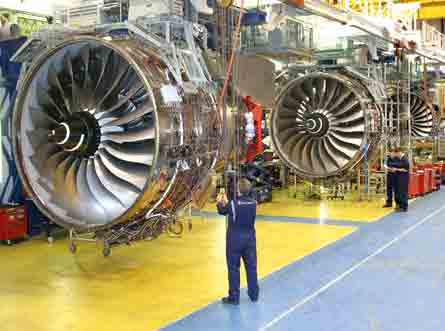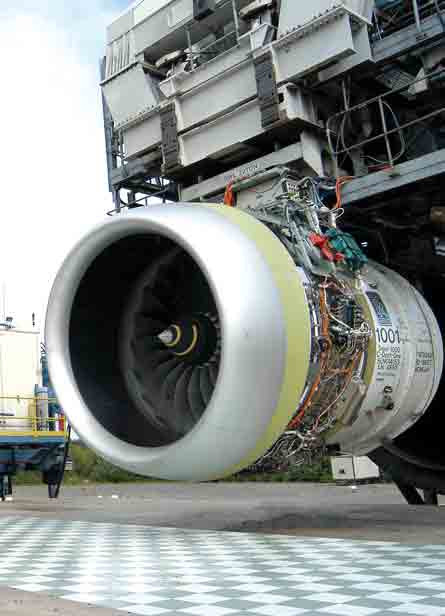The Rolls-Royce Trent 1000, launch engine for all three Boeing 787 variants, is in endurance testing and on track for certification by July 2007
Rolls-Royce’s Trent 1000 will be the launch engine on all three announced variants of the Boeing 787, the first time the UK engine maker has been lead supplier on an all-new Boeing widebody. Launch customer All Nippon Airways (ANA) will begin operating the 787-8 in mid-2008, followed by the short-range 787-3 in 2010. The same year, Air New Zealand plans to enter service with the 787-9.
Firm orders and options have been placed for 154 Trent-powered 787s by eight airlines and leasing companies, giving R-R its highest pre-delivery backlog for any widebody twin to date.
The sixth of seven ground test engines has joined the R-R Trent 1000 certification programme in the UK, with the last powerplant due for the destructive fan blade-off test by the end of December. “We’re well into type tests and have started endurance testing,” says Dominic Horwood, R-R director of Boeing programmes.
High-pressure (HP) and intermediate pressure (IP) telemetry tests are underway and “we have completed a significant proportion of the outdoor work, including crosswind and flutter tests. They’re going well and we’re making good progress,” says Horwood. Tests began on 14 February, marking the start of an 18-month certification effort as well as the inaugural run of the world’s first electrically started commercial turbofan. As the launch powerplant on the 787, and therefore the first to run, the engine is on schedule to be certificated at up to 75,000lb thrust (333kN) in July next year.
|
|---|
"We have completed a significant proportion of outdoor work; we are making good progress" Dominic Horwood, Rolls-Royce |
The three-shaft configuration of the Trent series, the development of which traces its roots to the RB.211 series, gave R-R a new design opportunity for the increased electrical load requirements of the 787. Unlike its predecessors, the Trent 1000 power off-take is from the aft of the IP compressor rather than the usual front end of the HP compressor, allowing a greater stability margin and lower flight and ground idle thrust.
By connecting inflight to the IP compressor, R-R says the combined starter/generator will enable sufficient power even at lower thrust settings in flight phases such as descent. As a result, the engine manufacturer says block fuel consumption will be reduced on shorter-range flights – such as those to be flown around the Japanese islands by launch customer ANA – by up to 6% compared with previous Trent engines.
A significant part of the test programme is therefore aimed at proving the reliability of the new electric start and power generation system as well as the completely revised “more-electric” testbed facilities at Hucknall in the UK.
Although never before attempted on an aircraft powerplant of this size or type, the engine “started beautifully” first time using dual-use Hamilton Sundstrand starter/generators, and is “continuing to start well”, says Horwood. “We are consistently achieving start times well within Boeing’s requirements, whether with one or two starter/generators. In fact, with two starter/generators, we have been achieving start times in the 35-40s range, which is approximately twice as quick as conventional engine starting,” says the company.
Ground testing
Specialist outdoor ground testing, including noise measurement and certification requirements such as ingestion, fan blade containment and severe weather simulation, continues at Hucknall for now but will gradually transfer through 2007 to a new dedicated site at NASA’s Stennis Space Centre in Mississippi. “We’re going to do noise testing in Stennis next year,” says Horwood, who adds that “the Trent 1000 will be the first to do noise certification there”.
The first engine in the test effort is being used primarily for low-pressure system evaluation. Engine number two is aimed more specifically at IP system work, while the third engine forms the focus for HP system work. A fourth engine was originally due to go to the Arnold Engineering Development Center in Tullahoma, Tennessee, for altitude and icing tests mid-year, but will now travel there later than expected. R-R says that “due to availability constraints at AEDC, the initial testing slot booked was a little earlier in our development programme than we’d ideally have liked. So when an opportunity arose to send the engine to AEDC a little later in the programme, we took it: the benefit of sending it later is that we’ll have that much more development running under our belt, allowing us to really focus on the testing we perform at this facility, making maximum use of the time we have there.”
Engines five and six are dedicated to endurance and type testing, while the seventh is being prepared for fan blade-off tests. Overall, around 18 test engines will be involved in the ground and flight test programme. As well as the original seven ground test units, one is due to be flown on R-R’s Boeing 747-200 flying testbed, while a further 10 engines (eight plus two spares) will be involved in flight tests at Boeing with the first four “flight compliance and aircraft validation” 787s. R-R adds that “we have achieved over 87,000lb (3,950kN) of thrust during testing so far. We have also recently completed a 150h endurance test on engine 5, during which the engine was run at simulated max power conditions.”
Other leading design features of the Trent 1000 include the biggest and most swept set of outlet guide vanes made from superplastic-formed/diffusion-bonded titanium; a forged titanium, lightweight and acoustically-treated rigid fan case; and a new HP turbine casting design; as well as a higher temperature RR1000, R-R’s proprietary powder metallurgy alloy. This is used in the last two stages of the HP compressor drum and HP turbine disc. RR1000 is a powder nickel alloy introduced into the Trent 1000 to gain benefits in cycle operating temperature and component life. The engine maker has extensive experience of using power alloys in military applications over the last 20 years, and RR1000 has been validated successfully in technology demonstrator engines.
The IP compressor unusually also incorporates a de-icing system, in which 44 of the sector stators are pneumatically heated to prevent ice accumulation from freezing fog. Other features include a single-skin tiled combustor, which is more suited to the bleed-free requirements of the more-electric 787, and forced-air-cooled IP turbine blades.
A battery of rig tests are either being completed or are still underway. A 0.86m (2.82ft)-diameter scaled aerodynamic fan rig test at AneCom AeroTest in Wildau, near Berlin in Germany was completed in 2005 and “met all expectations”, says Horwood.
|
|---|
Rolls-Royce's Trent 1000 undergoes crosswind tests at the company's Hucknall test site |
Similarly positive results emerged from a multi-sector Phase 5 combustor rig test as well as an IP compressor rig test. “We met or exceeded our emissions targets [relative to CAEP 6],” says Horwood, who adds that more performance margin will be achieved as a result of “tweaks” being made as a result. “We’ve been able to optimise the control schedules to refine the aerodynamic design of the IP compressor, and in the combustor we’ve used the tests to refine the right flow and get the right cooling design to optimise emissions,” he says.
Extensive conversion
Modification work is meanwhile continuing at L-3 Communications Integrated Systems on the 747, the company’s first dedicated flying testbed since the early 1970s when an RAF Type 1106 variant of the Vickers VC10 was used to test the original RB.211. Based at L-3’s Waco, Texas site the RB211-524C2-powered aircraft, acquired by R-R from Air Atlanta Icelandic, has been re-registered N787RR and is expected to make its first flight with the Trent 1000 in February.
“The wing has been modified to allow the test engine to be positioned inboard, and it has been strengthened to take the weight of the heavier engine,” says Horwood, who adds that the aircraft is extensively converted inside to “cope with the more electric requirements, such as the starter/generator control system and load banks to shed the electricity”. The engine for the flight testbed is due to be sent to Texas “towards the end of the year”, he adds. ■
For more news relating to the Boeing 747 please visit our 747 page
Source: Flight International

























